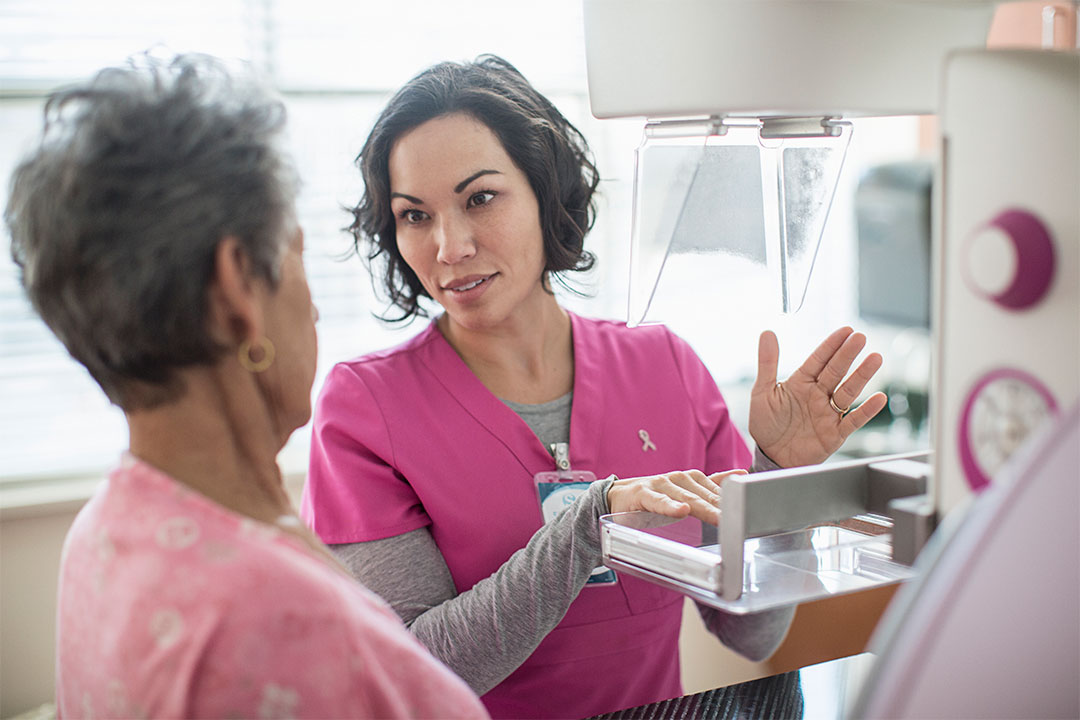As radiologists, one of the toughest parts of our job is diagnosing a patient with cancer. Approximately, 3.6 billion diagnostic x-ray examinations are performed every year globally and radiologists need to interpret one image every 3-4 seconds in an eight hour workday. Increase in imaging volume and demand to read large volumes of studies is causing delays in care. All patients deserve timely, precise and compassionate care.
Fortunately, advances in technology such as 3-D mammography (tomosynthesis) and breast MRI make it possible to diagnose cancer earlier than before. And advances in immunotherapy, proton therapy, and other treatments offer increasingly better outcomes.
The earlier we can detect the cancer, the more we can do to make sure that patients live long and healthy lives after diagnosis. When cancer is detected in the localized stage, before it has spread outside the breast, the five-year relative survival rate is 99%.
Sixty-four percent of breast cancers are caught in the early, localized stage; ideally we would detect 100 percent of breast cancers before they spread.
Several factors complicate our ability to reach that goal:
- New cases of breast cancer are expected to rise by 10% from 2020-2030.
- The volume of patients is increasing, because so many people put off being screened during the pandemic. In 2023, an estimated 297,790 women will be diagnosed with breast cancer in the U.S. along with 2,800 men.
- Even the diagnostic technology we use poses challenges. One of our biggest challenges is reading images across multiple software programs that don’t talk to each other.
How can we effectively diagnose and care for patients during a time of high demand while minimizing the inefficiencies that are too often a feature of today’s health system?
The good news is technology is evolving to make that possible and there is a need for advanced imaging technology in health systems amid the staff burnout we are facing. 81% of health systems report shortages in radiologists. Innovations are improving radiology workflows and surfacing all the information we need to make a timely, accurate diagnosis. Physicians no longer need to be tied to a single mammography workstation. With advanced software, they can view images from multiple sources—digital mammography, MRIs, and digital breast tomosynthesis—from any workstation. Current and prior images can be sequentially displayed for increased accuracy and complete diagnosis.
Advanced technology can also detect anomalies in breast studies so physicians can make a more accurate diagnosis and develop effective treatment plans. These new technologies enable radiologists to spend less time on administrative work and more time with patients. The benefits include increased productivity, which means patients can be diagnosed and treated more quickly, and less burnout.
By increasing the number of cancers detected at earlier stages, we can also reduce dramatic disparities in breast cancer outcomes. Black, Hispanic, and Indigenous women are more likely to be diagnosed with later stage cancers than white or Asian women, increasing their risk of mortality. While men are much less likely than women to develop breast cancer than women, they, too, are often diagnosed in later stages.
Here, too, technology can help us get people screened regularly. Once a patient is in our system, we can interact with them to be sure they have timely mammograms through features like automated reminders, and other forms of assistance.
As radiologists, we care for our patients and encourage them to be mindful of screening recommendations to be sure they are screened on time. New draft recommendations advise that all women ages 40-74 be screened every other year. The bottom line: all women are at risk of breast cancer, even if they do not have a family history of the disease. It is important for them to be screened starting at age 40, if they find a lump, have a family history of breast cancer, or anytime a physician recommends doing so.
As one cancer survivor puts it, “Days and weeks can make a difference in spread and outcomes. A mammogram is a very small thing to ask of yourself. It really is just an afternoon out of your life to have peace of mind or that could possibly save your life. So don’t put it off.”
The important thing to remember is that we are improving diagnostic and treatment technologies constantly. While earlier diagnosis tends to lead to better outcomes, treatments and therapies for more advanced stage cancers are always advancing. There is hope.
About authors
Sonia Gupta, MD
Sonia Gupta, MD is the chief medical officer of enterprise imaging at Optum and an abdominal radiologist at Radiologist Associates of Florida (RAF). She is a board member of the American Board of Artificial Intelligence in Medicine and an editorial board member of Applied Radiology. Dr. Gupta is a frequent keynote speaker and educator with former faculty appointments at Harvard Medical School and Temple University School of Medicine.
Anand Narayan, MD, PhD
Anand Narayan, MD, PHD is the breast imaging radiologist and vice chair of health equity at University of Wisconsin Carbone Cancer Center. He earned his medical degree from Johns Hopkins University School of Medicine and completed a fellowship at Memorial Sloan Kettering Cancer Center.

